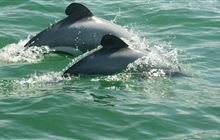Toxoplasmosis confirmed as cause of dolphin’s death
Archived content: This media release was accurate on the date of publication.
Introduction
An adult male Māui or Hector’s dolphin found dead on an isolated south Auckland beach has been determined to have died from toxoplasmosis.Date: 18 April 2023
The dolphin was discovered at Walton’s Gap, on the Āwhitu Peninsula in March, by a member of the public who reported it to DOC.
DOC’s Acting Marine Species Manager Kristina Hillock says the dolphin was sent for necropsy at Massey University, the results of which confirm it died from toxoplasmosis.
Toxoplasmosis develops when mammals ingest the Toxoplasma gondii parasite. The disease has been identified as a threat to the Māui and Hector’s dolphins who inhabit the oceans around New Zealand.
“Analysis of several of the dead dolphin’s internal organs – including its brain, heart and liver – revealed significant lesions consistent with toxoplasmosis,” Kristina Hillock says.
“The toxoplasma parasite was found amongst widespread severe tissue damage which confirms the dolphin died of toxoplasmosis.”
DOC is still awaiting results from genetic testing to determine whether this is a Māui or Hector’s dolphin. It is impossible to tell the difference between the two sub-species without genetic analysis, as they are otherwise identical.
If the animal is a Māui dolphin, this will be the first confirmed Māui dolphin death from toxoplasmosis since 2010.
Cats and their faeces are a known vector for the disease. Cats are the only animals in which the parasite can sexually reproduce, the oocysts (eggs) of the parasite are spread into the environment in the cat’s faeces and dispersed via rainwater and wastewater, which eventually reaches the sea. The dolphins likely become infected when they eat prey which have ingested oocysts, allowing the disease to take hold.
Toxoplasmosis is a cause of death for marine mammals around the world.
Kristina Hillock reiterated DOC’s call to the public to report any dead Māui or Hector’s dolphins as soon as possible, as this gives the best opportunity for valuable necropsy and science to be carried out to learn more about the dolphins.
Background information
The Māui dolphins are one of the smallest and rarest dolphin species in the world. They are only found off the west coast of New Zealand’s North Island, in a range from south Taranaki to Auckland. Their conservation classification is “nationally critical” and they face threats from fishing, human activities such as gas and oil exploration, and toxoplasmosis.
They are identifiable by their rounded dorsal fin, which is often likened to the shape a Mickey Mouse ear.
As part of a significant spend on conservation in Budget 2022, the Government committed $4.88 million to a three-year work programme focussing on toxoplasmosis, and how it impacts Māui dolphins.
This funding starts in the 2023/24 financial year and will be spent on research to inform actions to reduce the risk to Māui dolphins from toxoplasmosis.
People can help prevent the Toxoplasma gondii parasite from reaching Hector’s and Māui dolphins:
- keep cats indoors
- dispose of cat faeces in the rubbish bin, not the toilet
- spay or neuter your cat
- do not abandon unwanted cats or feed feral or stray cats
- support wetland conservation, which helps stop toxoplasma eggs reaching the ocean
- include green spaces in your garden or backyard to help filter rainwater and reduce stormwater runoff.
Contact
For media enquiries contact:
Email: media@doc.govt.nz

